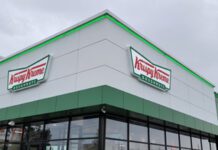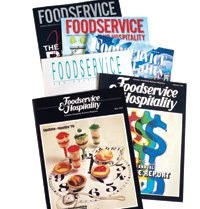When F&H debuted in 1968, the Beatles were still performing, Neil Armstrong had yet to land on the moon and McDonald’s Restaurants of Canada had barely just arrived on the Canadian landscape. It’s hard to believe how much has changed in the nearly half a century since the magazine began covering the dynamic foodservice-and-hospitality scene. Back then, the industry didn’t carry the same clout as it does today, with only a handful of chains and a smattering of independents making headlines and posting multi-million-dollar annual sales.
Tim Hortons, a national icon today, was but four years old in 1968, and Tim Horton himself was still playing hockey. Little could we have known that the foodservice industry would grow and evolve to the status it now enjoys or that restaurants would become as frequented as they are today — and so integral to our lifestyle. Then again, who would have ever imagined that chefs themselves would take on “rock-star” status and food would become as dissected, as discussed and as debated as it is today, with so many cultural, ethical and societal ramifications. One can only imagine what the next 45 years will herald.
— Rosanna Caira
 Table Manners
Table Manners
Women’s lib, breakfast and finger foods, made an impact on the foodservice industry in the 70’s
By Jackie Sloat-Spencer
Pizza Party: On a chilly New Year’s Eve in 1967, Pizza Pizza opened its first location at the corner of Wellesley and Parliament Streets in Toronto.
Burn Baby Burn: Tableside entertainment heated up with the newfound popularity of flambéing. A favourite was the Crêpe Suzette, which was set ablaze with a squirt of Brandy.
Rise and Shine: In 1971, a simple invention changed the course of the QSR breakfast sandwich when Herb Peterson, a McDonald’s franchisee, designed a handheld version of the Eggs Benedict. By 1976, McDonald’s released a breakfast menu, featuring the Egg McMuffin.
Do the Dip: In the 1970s, on-trend restaurateurs were offering tabletop fondue pots for dipping breads, fruits and meats. A favourite Canadian spot was Vancouver’s Fondue Inn, which served a swiss-cheese fondue ($4.95) and chocolate fondue ($2.75).
Equal Rights: Feminist writer Betty Friedan’s 1963 book, The Feminine Mystique inspired women to join the workplace, but it was hard to win top jobs in the kitchen. “Girls are left with the salad and sandwich positions — the average restaurant, for example, just doesn’t hire a man to do salads, and they won’t hire a woman for the best job,” Trude Spika, a Southern Alberta Institute of Technology foodservices instructor told CRA magazine in July 1971.
QSR Top Dogs: McDonald’s, Kentucky Fried Chicken and A&W were the top three franchising organizations of the mid-1970s, according to F&H’s second-annual franchising report.
Raising the Bar: After a tainted beef scare in retail outlets, the public became concerned about sanitation practices in the foodservice industry. Thanks to a $600,000 fund and widespread industry support, the National Sanitation Training program was born, training up to 6,000 students in a three-year program.
 Opportunity Knocks
Opportunity Knocks
Technology, growth and innovation were key drivers in the ’80s
By Brianne Binelli
Celebrate Good Times: 1983 marked Cara Operations’ 100th anniversary. Originally named The Canada Railway News Company, it morphed into a multi-faceted organization, including brands such as Swiss Chalet and Harvey’s.
An Experiment: Nicholas Kurti, an Oxford physics professor, was said to have coined the term ‘molecular gastronomy’ in the ’80s. The technique, which combines science with the art of cooking, was later popularized by famed chefs such as Ferran Adrià in Spain and Heston Blumenthal in England.
Virgin Refreshers: As campaigns against drunk driving ignited during the decade, bartenders responded by adding non-alcoholic mocktails to their drink menus.
Mixing it Up: Fusion food was a hot trend in the ’80s. In 1987, renowned chef Susur Lee was cooking dishes such as Chinese ravioli and black olive sauce with corn and crab bisque at his new Lotus restaurant in Toronto.
Tech-Happy: The ’80s were a time of technological advancements. According to the F&H archives, Squirrel introduced a POS system called The Li’l Squirrel in 1988. It retailed for $9,000 and offered operators modern, compact equipment to fit their growing needs.
A New Sibling: In 1988, Kostuch Publications introduced Hotelier magazine, the new sister to Foodservice and Hospitality.
Marking Milestones: The ’80s were a big decade for McDonald’s Canada. In 1988, George Cohon, president and CEO, announced plans to open 20 restaurants in Moscow in what was reported to be the largest agreement ever signed between a food company and the Soviet Union. Meanwhile, the next year, the exec celebrated the opening of the 600th McDonald’s restaurant in Canada at the iconic SkyDome baseball stadium in the heart of Toronto.
A Prime Example: The landscape of the foodservice scene shifted in 1989 when Prime Restaurant Systems Inc., (owned by Rothchild Holdings Inc.,) purchased the Pat and Mario’s, East Side Mario’s and Casey’s franchising systems from Yesac Creative Foods Inc.
 Growth Spurt
Growth Spurt
The growth of the Internet and evolution of the customer created a new urgency for convenience and value in the ’90s
By Hildegard van Niekerk
Family matters: Women spent more time at work and less time at home, spurring an eating-out evolution. It meant fine-dining lost market share to casual family restaurants as romantic dinners for two became more of a family affair. Guests and operators alike flocked to find better value for money with kids’ meals and coupons.
Message on the bottle: The Vintners Quality Assurance (VQA), founded in Ontario in 1988 by Donald Ziraldo (co-founder of Inniskillin Wines), was made the province’s designated wine authority in the 1999 VQA Act. In 1990, Canada’s wine appellations expanded as VQA was launched in B.C.
Big Brother is watching: Government regulations took their toll on operators in the ’90s. On New Year’s Day in 1991, the seven-per-cent goods-and-services tax (GST) went into effect. The decade was also marked by changes to smoking regulations, liquor legislation, employment standards, equity laws and accessibility requirements.
Blast off to cyberspace: The foodservice industry went digital with the commercialization of the Internet. Cyber cafés — which originated in London, England in 1994 with the opening of Cyberia — soon spread across the globe, making email and espresso a hit duo.
Tim and Wendy’s affair: In 1995, Tim Hortons merged with Wendy’s International Inc. (The affair ended with the separation of the two brands in 2006.)
Ancillary artillery: Convenience stores began offering packaged sandwiches, muffins, hamburgers and pizzas (and the use of a microwave) for on-the-go customers. Quick-service restaurants also partnered with supermarkets, department stores and convenience stores. It was a time when express Tim Hortons sites began to invade gas stations.
Talk to the hand: Bagels, sandwiches and wraps were the “it” foods of the decade. Canadian brands such as The Great Canadian Bagel (1993), Pita Pit (1995), Tim Hortons (which launched bagels in 1996) and Extreme Pita (1997) cashed in.
 A whole new world
A whole new world
Foodservice went through a metamorphosis in the ’00s
By Rosanna Caira
Y2What?:Despite the debate as to whether the new millennium began in 2000 or 2001, the industry and the world fixated on Y2K, fearing computers would crash and create mass calamity. But the new century came and went without a hitch. Still, fear was pervasive as 9/11, SARS and the Avian flu shaped what we ate, where we travelled and how we lived.
Food safety first: An April 2000 Toronto Star series called “Dirty Dining” put food safety in restaurants under the microscope, and crises like BSE (Mad Cow Disease), the Walkerton Water Crisis and a Hepatitis scare at Capers Restaurant in Kitsilano, Vancouver further reinforced the importance of food safety.
Desperately seeking workers: Labour shortages continued to create buzz as restaurateurs struggled to fill jobs. And, it got worse in 2001 when the Bank of Canada announced the country’s
unemployment rate was the lowest it had been in 25 years. Meanwhile, Kostuch Publications held its first Labour 20/20 conference in May 2007.
A New Beginning: A collection of fine-dining restaurants, including Toronto’s Avalon and Truffles, closed their doors. On the flip side, in 2003, Joey Tomato’s, the precursor of Joey Restaurants, opened in Calgary, marking a new era for casual dining.
Healthy Eating: Whether fuelled by aging boomers or consumers’ new appreciation for better living, healthy food was the hottest trend of the decade, witnessed by the elimination of trans fats in food products as well as more healthy options on the menu, reduced sodium and a continuing discussion about nutritional labelling and obesity. In 2004, McDonald’s launched its Healthy Lifestyle Menu.
Meat Mania: Better burgers, steaks and a fascination with charcuterie put meat in the spotlight and turned chefs into butchers.
Keeping it Real: Consumers and operators alike embraced local, seasonal fare, giving rise to the term “locavore” and a new appreciation for food products grown in our backyard.
U.S. Invasion: Today, American chains are hotter than ever with concepts such as Five Guys Burgers and Fries, Menchie’s, Chipotle Mexican Grill and Panera Bread finding success north of the border.





















